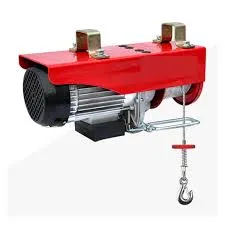


Lifting Equipment Essential Tools in Modern Industry
In today's fast-paced industrial environment, lifting equipment plays a crucial role in enhancing productivity and ensuring safety. From construction sites to manufacturing plants, the ability to lift, move, and position heavy loads efficiently is vital for the smooth operation of any business. This article delves into the various types of lifting equipment, their applications, and the significance of choosing the right gear.
Lifting equipment encompasses a wide range of devices designed to raise and lower heavy objects. Common types include cranes, hoists, forklifts, and elevating platforms. Each of these tools serves a distinct purpose, allowing operators to carry out tasks that would otherwise be impossible or dangerous. Cranes, for instance, are often employed in construction and shipping industries for moving massive materials, while forklifts are essential in warehouses for transporting goods over short distances.
One of the most critical aspects of using lifting equipment is understanding its specifications and limitations. Each piece of equipment is designed with a specific load capacity, and exceeding this limit can lead to catastrophic failures. Regular maintenance and inspections are necessary to ensure that the equipment remains in optimal condition. Operators must also be trained and certified to use these machines properly, as improper handling can result in accidents that endanger lives and property.

Safety is paramount in industries that rely on lifting equipment. The risks associated with lifting operations include load drops, structural failure, and operator injuries. Therefore, adhering to safety protocols is essential. Safety measures can include using appropriate personal protective equipment (PPE), conducting regular training sessions, and implementing comprehensive safety programs. Employers have a responsibility to create a culture of safety, where employees are encouraged to report hazards and participate in safety drills.
In recent years, advancements in technology have transformed the lifting equipment industry significantly. Innovations such as telematics, remote control systems, and automated lifting solutions have enhanced efficiency, reduced human error, and improved safety outcomes. For example, remote-controlled cranes allow operators to handle materials from a safe distance, minimizing the risk of injury. Additionally, the integration of smart sensors helps monitor load weights and equipment conditions in real time, enabling proactive maintenance and reducing downtime.
When selecting lifting equipment, businesses must consider various factors, such as the nature of the job, the weight and size of the loads, and the work environment. Investing in high-quality, reliable equipment is essential, as it directly impacts productivity and safety. Companies must also be aware of regulatory requirements pertaining to lifting equipment, as compliance ensures not only legal adherence but also the safety of all involved in the lifting operations.
In conclusion, lifting equipment is an integral component of modern industry, facilitating the movement of heavy loads while prioritizing safety and efficiency. As technology evolves, so too does the lifting equipment landscape, presenting new opportunities and challenges for industries worldwide. By understanding the importance of proper selection, maintenance, and operation of these tools, businesses can enhance productivity while ensuring a safe working environment for their employees.



